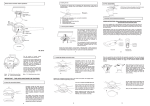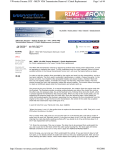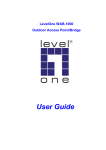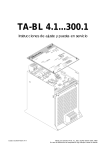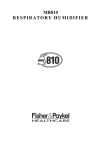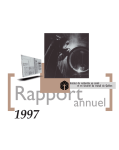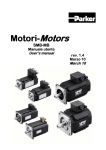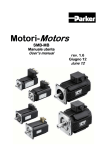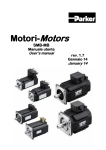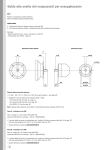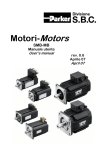Download Giantmix FR1, FR3, FR4, FR5, FR6 Operating instructions
Transcript
Long-axis agitators Giantmix FR1, FR3, FR4, FR5, FR6 for biogas plants Operating instructions Original edition Subject to technical changes. Version: 2011-10 Giantmix FR - operating instructions Inhaltsverzeichnis 1. User guide 1.1 Warning notices 4 1.2 Further symbols 5 1.3 Accompanying documents (see enclosures) 5 1.4 Storage 5 2. Safety 6 2.1 Symbols on the product 6 2.2 Safety notices 6 2.3 Product liability 8 3. Intended use 9 4. Improper usage 10 5. Delivery scope 10 5.1 Standard design with sealing plate 10 5.2 Design with slewing ring and sealing frame 11 5.3 Accessories (optional) 11 6. Transport and storage 12 7. Installation 13 8. Assembly 14 8.1 Design 14 8.2 Check the scraper 14 8.3 Operating and ambient conditions 15 8.4 Prior to installation 15 8.5 Installation material and aids 15 8.6 Prerequisites for installation in the biogas tank wall 15 8.7 Make an opening in the wall of the biogas tank 16 8.8 Attach the tie bolts 19 8.9 Installation in the biogas tank wall 19 8.10 Connecting the electricity supply. 21 8.11 After installation 23 9. Agitation 2 4 24 9.1 Requirements 24 9.2 Rotation direction of the propeller 24 Giantmix FR - operating instructions 9.3 Optimum agitation 24 9.4 Height adjustment of the agitator 25 9.5 Optional drive of the agitator with power take-off 26 9.6 Setting the rotation angle (Giantmix FR with slewing ring) 27 10.Errors and trouble-shooting 28 11. Inspection and maintenance 31 11.1 Prior to maintenance work 31 11.2 Maintenance log 31 11.3 Starting torques 32 11.4 Maintenance plan 33 11.5 Wear-related maintenance 34 12.Repair 37 12.1 Replacing the propeller 37 12.2 Replace slip-on shaft (drive shaft). 37 12.3 Replace bearings 37 12.4 Replacing the transmission 37 12.5 Replacing the motor 37 13.Disassembly 38 13.1 Prior to disassembly 38 13.2 Disassembly 38 14.Disposal 39 15.Technical data 39 15.1 Type plate 39 15.2 Technical data 40 16.Maintenance log 41 17.Biogas safety information 42 17.1 Ternary diagram 42 18.Permit for work in explosive areas 43 19.Check list for commissioning 44 3 Giantmix FR - operating instructions 1. User guide 1.1 Warning notices Degree of warning notices The following signal words distinguish the warning notices according to the type of danger: • Caution: Warning of damage to assets. • Warning: Warning of injuries to the body. • Danger: Warning of mortal danger. Structure of the warning notices SIGNAL WORD Type and source of danger. ÂÂ Measures to prevent danger. Used pictograms Danger of explosion. May cause death or injury. Danger of damage to assets or the environment. 4 Giantmix FR - operating instructions 1.2 Further symbols Notices Notice Notice on the proper handling of the device. Handling instructions Layout of the handling instructions: ÂÂ Handling instruction. Statement of result if necessary. Lists Structure of non-numbered lists: • List level 1 –– List level 2 Structure of numbered lists: 1. List level 1 2. List level 1 2.1 List level 2 2.2 List level 2 1.3 Accompanying documents (see enclosures) Observe the following documents for safe and reliable operation: • Handling instructions for the electric motor • Handling instructions for the cardan shaft (optional) • Ex-zone plan of the respective biogas plant (to be prepared by the operator) 1.4 Storage ÂÂ Keep operating instructions (including the accompanying documents) near the propeller mixer. 5 Giantmix FR - operating instructions 2. Safety 2.1 Symbols on the product The following safety and health protection notices are located on the sealing plate (BGV A8 / DIN 4844): Warning of explosive atmosphere! 2.2 Safety notices Safety notices serve to prevent injury to persons and damage to the Giantmix FR and the environment. The following applies for the operating personnel: ÂÂ Read and observe all safety notices. Danger of injury To prevent risks of injury: ÂÂ Observe the accident prevention regulations for agricultural biogas plants. ÂÂ Observe the accident prevention regulations of the Operational Safety Ordinance (BetrSichV). ÂÂ Observe all rules of technology. ÂÂ Observe all safety notices. ÂÂ Provide and observe the national and regional regulations for accident protection and occupational safety. ÂÂ Provide and observe environmental protection regulations. ÂÂ Make sure that persons under the influence of alcohol, drugs or medication do not transport, set up, commission, operate and/or repair the Giantmix FR. ÂÂ Make sure that the operating personnel is at least 18 years old. ÂÂ Make sure that the operating personnel is instructed at regular intervals on all questions concerning industrial safety and environmental protection. ÂÂ Make sure that the operating personnel has read and observes the operating instructions. ÂÂ Observe all warning and notice signs on the Giantmix FR. ÂÂ Make sure that the warning and notice signs are attached and legible. Prior to working in and on the biogas tank, the agitator and the electric equipment: ÂÂ Turn off the main switch and secure it against accidental re-activation with a padlock. ÂÂ Pull off the key and attach a corresponding warning sign. ÂÂ Use personal safety equipment. E.g. safety belt, safety rope, gas indicator, respiratory protection, safety shoes, protective gloves, etc. ÂÂ Make sure that the Giantmix FR is not operated without the safety equipment and protective covers attached by the manufacturer or in the factory. ÂÂ Have defects on the Giantmix FR repaired immediately. ÂÂ Do not modify or convert the Giantmix FR. –– This will render the declaration of conformity null and void. –– The operating permit expires. 6 Giantmix FR - operating instructions In order to maintain the safety, function and protection from explosion: ÂÂ Exclusively replace parts with OEM parts with identical electric and mechanical data. ÂÂ Check all safety equipment (e.g. the sealing membranes), attachments as well as electric connections and leads for perfect condition at regular intervals. Danger of damage to the environment ÂÂ Make sure that lubricants or transmission oil do not flow into the ground, the water or the sewage system. ÂÂ Properly dispose of lubricant remnants, waste oil and containers/rags contaminated with these substances. ÂÂ After de-commissioning the Giantmix FR, dispose of parts according to national, regional and statutory regulations. ÂÂ Observe the national, regional and statutory regulations when disposing. Danger through explosive and flammable atmosphere. It is possible that poisonous, flammable and explosive gases escape from the biogas tank. ÂÂ Make sure that exclusively trained personnel performs installation and maintenance work on explosionproof machines in line with the Operational Safety Ordinance (BetrSichV) and the safety and maintenance notices stated in operating instructions. ÂÂ Prevent an explosive atmosphere around tank openings during maintenance work. ÂÂ Work that influences explosion protection may exclusively be performed by trained or qualified personnel. ÂÂ Make sure that the permit for work in explosive areas is completed prior to any work on the Giantmix FR and signed by the person in charge. If the work is not performed by SUMA: ÂÂ Make sure that all work is performed and approved by trained and certified personnel exclusively. ÂÂ Make sure that the trained personnel issues a written confirmation and/or attaches their test seal on the machine. Keep the confirmation in the operator's explosion prevention documentation and present this upon demand. Higher risk of explosion It is possible that gas escapes when opening or removing the Giantmix FR. ÂÂ Keep all ignition sources (e.g. open flames, hot heat sources, tools emitting sparks, non-explosion-proof electric devices) away from the explosive zones (ex zones). ÂÂ Exclusively use spark-free tools. –– Make sure that the used tool (e.g. power drill, driller, core drill, chisel) is a special spark-free tool. ÂÂ Make sure that welding, burning and spark-emitting work is not performed inside the ex zones. ÂÂ To prevent the risk of fire, make sure that the transmission and motor are clean (surface). In the range of the biogas plant: ÂÂ Observe the regulations for biogas plants. ÂÂ Do not smoke. ÂÂ Do not use any open sources of fire. ÂÂ Do not use any mobile phones or other source of ignition. ÂÂ Ventilate the biogas tank sufficiently prior to performing all installation and maintenance work. 7 Giantmix FR - operating instructions 2.3 Product liability Liability exclusion SUMA will not assume any liability for damage to persons, assets, the environment and/or breakdowns caused by non-observance of the operating instructions. The warranty does not cover unauthorised intervention or modification. SUMA will assume no liability and warranty for damage to persons, materials and/or breakdown of the caused by the installation of replacement parts not approved by SUMA. SUMA excludes warranty and liability claims for damage to persons, assets and the environment caused by the following: • Unauthorised application of the Giantmix FR. • Improper transport, installation, deinstallation, commissioning, operation or maintenance of the Giantmix FR. • Non-observance of the notices in the operating instructions concerning installation, deinstallation, commissioning, operation and maintenance. • Operating the machine with: –– defect safety and protection equipment. –– improperly attached safety and protection equipment. –– defect safety and protection equipment. • Unauthorised modifications of the motor (e.g. drive ratios). • Insufficient monitoring of wear and tear parts. • Improperly performed repair work. • Foreign object damage, e.g. through insertion of solid objects in the biogas tank that are not suited for the biogas process. Please refer to the General Terms and Conditions or the contract documents for details on the warranty. 8 Giantmix FR - operating instructions 3. Intended use The biogas agitator Giantmix FR serves to mix renewable resources, liquid manure and sewage sludge in concrete biogas tanks. The Giantmix FR corresponds to device group II category 2G (mechanical components) and/or 3G (electric components) in accordance with the Explosion Protection Directive 94/9/EC. The Giantmix FR is approved for use in explosive environments in accordance with the Declaration of Conformity for zone 2. DANGER Mortal danger through explosion! ÂÂ Use Giantmix FR exclusively in explosive areas of ex zones corresponding to the details on the type plate of the respective device. Conditions for the proper use of the agitator: ÂÂ Make sure that the conformity of the end product is warranted in line with the applicable directive after installation and/or assembly with other components. ÂÂ Ensure sufficiently dimensioned attachment of the agitator. ÂÂ Make sure that the maximum pressure on the pipe duct (sealing membrane) is in the admissible range. ÂÂ Make sure that the temperature of the substrate to be agitated does not exceed 70°C (158°F). ÂÂ Make sure that the pH value of the substrate to be agitated is between 6.5 and 8.2. ÂÂ Make sure that all safety and monitoring equipment (e.g. thermal sensor of the electric motor, contact switch on the power take-off) are connected and functioning. ÂÂ Make sure that the agitator blade is completely covered with substrate for operation. ÂÂ Observe the inspection and maintenance intervals. ÂÂ Observe the safety, permission, prohibition, warning and operating instructions. If changing the installation site or the operating situation of the Giantmix FR: ÂÂ Check the ex zones and compare with the ex protection type of the Giantmix FR. 9 Giantmix FR - operating instructions 4. Improper usage DANGER Mortal danger through explosion! With a Giantmix FR featuring an optional drive with a cardan shaft: ÂÂ Do not operate with the power take-off if power take-off or drive motor (tractor) are located in an explosive area (see „Agitation“ on page 24 ). Improper use of the agitator with: • Operation via the cardan shaft without protective equipment (see operating instructions of the cardan shaft). • Operation in an inadmissible Ex zone. Use other than that described in the chapter "Intended use" is not permitted. The operator of the Giantmix FR is responsible for all damage caused by improper use. In order to ensure safe operation and prevent damage to the Giantmix FR: ÂÂ Make sure that the substrate to be agitated does not contain the following goods, foreign substances or foreign objects. –– Slaughterhouse waste (bones etc.) –– Bulky, sharp-edged solid substances (square timber, wooden boards, branches, etc.) –– Metal and non-metal parts (e.g. iron rods, steel wire, chains, etc.) –– Long-fibred and other clogging products 5. Delivery scope Notice The delivery scope may deviate from the image on the title page. 5.1 Standard design with sealing plate Name Complete biogas agitator (including sealing plate 30°, agitator tube, gear, electric motor, propeller, sealing membrane or rubber compression seal (optional), hinge)* Attachment material sealing plate on tank wall: tie bolt M12 x 130, galvanised, complete with nuts and disks 1 1 set (27 pcs) Upper control arm or toothed rack with winch (optional), wall mount, tie bolt M12 x 130 (3 pcs.), galvanised, complete with nuts and disks 1 set Rubber sealing strips (4 pcs. 900 x 80 x 6) 1 set Drill bush 1 set * see fig. 2 on page 13 10 Quantity Giantmix FR - operating instructions 5.2 Design with slewing ring and sealing frame Name Complete biogas agitator (incl. slewing ring and sealing frame, agitator tube, gear, electric motor, propeller, sealing membrane, pivoting frame)* Attachment material sealing plate on tank wall: tie bolt M12 x 130, galvanised, complete with nuts and disks Quantity 1 1 set (30 pcs) Upper control arm (2 pcs.), wall mount (2 pcs.), tie bolts M12 x 130 (6 pcs.), galvanised, complete with nuts and disks 1 set Toothed rack with winch (optional), wall mount, tie bolts M12 x 130 (3 pcs.), galvanised, complete with nuts and disks 1 set Rubber sealing strips (4 pcs. 900 x 80 x 6) 1 set Drill bush 1 set * see fig. 3 on page 13 5.3 Accessories (optional) Name Quantity Drill stencil 1 Dummy cover 980 (98 cm x 98 cm) 1 Protective hood for electric motor 1 Flexible connection cable 7x4 + 2x1 mm² for max. 15 kW (FR4) per metre Flexible connection cable 4x10 + 4x1 mm² for soft start or frequency converter operation (FR5 and FR6) per metre Additional special accessories on request. Notice SUMA delivers the Giantmix FR without a switch box. ÂÂ Make sure that the safety and monitoring equipment (e.g. emergency stop and start-up control) are installed on the biogas plant and in working condition. 11 Giantmix FR - operating instructions 6. Transport and storage WARNING Danger of injury through improperly secured parts! ÂÂ Use suitable lifting equipment (e.g. digger, crane, etc.). ÂÂ Make sure that no persons are located beneath the load when lifting, transporting and unloading lowering the Giantmix FR. ÂÂ Always supervise the load while it is suspended. ÂÂ Do not reach in beneath the propeller agitator when lifting and lowering. ÂÂ Never reach into moving parts. Transport: ÂÂ Transport the Giantmix FR in a horizontal position. ÂÂ Use suitable lifting equipment (see weight on the type plate of the Giantmix FR). ÂÂ Make sure that the lifting equipment is suited for the weight stated on the type plate. ÂÂ Do not lift the agitator on the motor only (use attachment points, see fig. 1). Notice The following applies for both variants: If the pipe is longer than 4 m, attach counterweight in the rear on the transmission and align the agitator horizontally. Storage: ÂÂ To prevent the sealing surfaces from sticking together, turn the propeller every 2 months. ÂÂ Store the Giantmix FR at a temperature between -15°C (4°F) and +40°C (104°F). 1 2 1 3 fig. 1: Giantmix FR's attachment points 1 Attachment points 2 Transport securing device with ring eyelet 12 3 Wooden wedge as transport securing device Giantmix FR - operating instructions 7. Installation 1 2 3 4 10 fig. 2: 4 Sealing membrane or rubber compression seal (optional) 5 Electric motor 1 7 9 8 6 Oil equalizing container 7 Spur gearing, two-stage 8 Upper control arm or toothed rod with winch (optional) 9 Shaft tube support bracket (with hinge installation) 10 Scraper 2 12 1 2 3 4 6 Propeller agitator Giantmix FR with sealing plate (standard design) 1 Propeller 2 Agitator rotor 3 Sealing plate 30° fig. 3: 5 3 4 11 5 6 7 10 9 8 Propeller agitator Giantmix FR with slewing ring and sealing frame Propeller Agitator rotor Sealing frame and cover plate Sealing membrane 5 Electric motor 6 Oil equalizing container 7 8 9 10 Spur gearing, two-stage Power take-off (optional) Slewing ring and slewing bracket Upper control arm or toothed rod with winch (optional) 11 Hinge installation 12 Scraper 13 Giantmix FR - operating instructions 8. Assembly DANGER Mortal danger through wrong assembly! ÂÂ Observe all details concerning the properties of the biogas tank wall (concrete quality, wall thickness, etc.) in the operating instructions of the biogas plant manufacturer. ÂÂ Make sure that the biogas tank is empty or that the substrate has settled sufficiently and that the biogas tank is ventilated. DANGER Mortal danger through explosion! ÂÂ Make sure that there is no explosive gas-air mix during the entire installation. DANGER Mortal danger through improper conduct during installation, deinstallation and repair work. ÂÂ Make sure that assembly work is only performed by trained or qualified personnel. ÂÂ Make sure that the Giantmix FR is not turned on - if it is not properly and completely installed in the biogas tank opening - if persons are located in the danger zone. ÂÂ Make sure that there are no persons (especially children) and/or animals present in the vicinity of the Giantmix FR during installation, deinstallation and repair work. ÂÂ Make sure that the Giantmix FR is not left unsupervised during installation, deinstallation and repair work. ÂÂ Use personal safety equipment. E.g. safety belt, safety rope, gas indicator, respiratory protection, safety shoes, protective gloves, etc. 8.1 Design The propeller agitator Giantmix FR is designed for installation from the outside. It is not necessary to climb into the biogas tank. 8.2 Check the scraper x fig. 4: Scraper distance Check scraper distance: ÂÂ Make sure that the distance x of the scraper is 3 mm. 14 Giantmix FR - operating instructions 8.3 Operating and ambient conditions Operating and ambient conditions for Giantmix FR: • Installation height < 1000 m above sea level • Relative air humidity of the cooling air max. 90% at 25°C (77°F) • Ambient temperature from -15°C (5°F) to +40°C (104°F) ÂÂ Keep air intake and blowout of the motor unobstructed. ÂÂ Prevent contamination through insects, maggots or corrosion through hazardous substances like hydrogen sulphide, chlorine, ammonia, ozone and nitrous oxides. 8.4 Prior to installation Observe the following prior to installing the Giantmix FR: ÂÂ Prior to retrospective installation, lower the fill level of the biogas tank sufficiently. ÂÂ Make sure that the biogas tank is ventilated. For more information see „Safety notices“ on page 6 8.5 Installation material and aids Name Quantity Drill stencil (recommended) 1 Tie bolt with nuts and disks 1 set Rubber sealing strips (4 pcs. 900 x 80 x 6) 1 set Sikaflex TS (provided by the customer if necessary to compensate gaps and unevenness) 1 8.6 Prerequisites for installation in the biogas tank wall Observe the following prerequisites for installation: ÂÂ Make sure that the static and dynamic design of the biogas tank is suited for inclusion of the agitator. ÂÂ Prior to installing ducts and making drill holes, check the wall of the biogas tank for tensioning and heating elements, steel reinforcements and similar. ÂÂ To ensure perfect impermeability and stability of the attachment, make sure that the wall of the biogas tank is sufficiently level (only a few hollow places and dents are admissible). 15 Giantmix FR - operating instructions 8.7 Make an opening in the wall of the biogas tank CAUTION Change of static through core drilling! ÂÂ Prior to retrospective drilling of core drill holes, check the static of the biogas tank or have it checked. For mere height adjustment, SUMA recommends a round opening/boring (fig. 5). For lateral adjustment via slewing ring, SUMA recommends a square opening (fig. 6). A square opening allows you to use the full lateral slewing range. With the slewing ring version, the lateral slewing range is 25° left/right respectively. Retrospective installation 2 1 4 fig. 5: 3 Opening in the wall of the biogas tank 1 Distance center of opening - normal fill level 2 Fill level 3 Core drilling 4 Center of opening ÂÂ Place the center of opening below normal fill level (covering). –– 50 cm to max. 100 cm (membrane 1x) –– 100 cm to max. 150 cm (membrane 2x) ÂÂ Make core drilling with min. Ø 60 cm and max. Ø 70 cm. ÂÂ When using the standard design, make sure that the boring is not larger than Ø 70 cm. Insufficient distance to the tie bolts with borings larger than Ø 70 cm. –– Optionally, SUMA supplies larger sealing plates with 120 cm x 120 cm or 143 cm x 143 cm. NOTICE For installation depths larger than 150 cm, SUMA offers special sealing membranes (upon request). NOTICE Positioning the center of the opening in the gas range is possible. Optimum agitation performance in horizontal range at approx. 50 cm below normal fill level. With a second joint seal (sealing membrane), it is possible to place the center of the opening up to max. 150 cm below normal fill level. 16 Giantmix FR - operating instructions Opening with new tank construction 2 1 3 5 4 fig. 6: Opening in the wall of the biogas tank 1 Distance center of opening - normal fill level 2 Fill level 3 Height of opening 4 Width of opening 5 Center of opening ÂÂ Place the center of opening below normal fill level (covering). –– 50 cm to max. 100 cm (membrane 1x) –– 100 cm to max. 150 cm (membrane 2x) ÂÂ Make opening with min. 60 cm x 60 cm and max. 70 cm x 70 cm. ÂÂ When using the standard design, make sure that the opening is not larger than 70 cm x 70 cm. There is no sufficient distance to the tie bolts with openings larger than 70 cm x 70 cm. –– Optionally, SUMA supplies larger sealing plates with 120 cm x 120 cm or 143 cm x 143 cm. NOTICE Reduce assembly and drilling time for anchor bolt holes: The additionally required steel reinforcement (concrete tanks) is not within the anchor bolts 90 cm x 90 cm contribute, but within or outside of it. NOTICE For installation depths larger than 150 cm, SUMA offers special sealing membranes (on request). NOTICE Positioning the center of the opening in the gas range is possible. Optimum agitation performance in horizontal range at approx. 50 cm below normal fill level. With a second joint seal (sealing membrane), it is possible to place the center of the opening up to max. 150 cm below normal fill level. 17 Giantmix FR - operating instructions Clearance for the cladding and the insulation material 72 110 110 30 18 DK 12 17 26 DK 67 110 fig. 7: Installation site for the standard sealing plate (dimensions stated in cm) Installation site: ÂÂ Keep the sections of the biogas tank wall shown in fig. 7 free from cladding and/or insulation material. ÂÂ Reserve at least 110 cm x 110 cm in the installation opening section for the standard sealing plate. Reserve larger sections accordingly for larger sealing plates. ÂÂ With the variant with a 30° sealing plate and a left-oriented alignment (agitation clockwise), reserve the position labelled 30° (fig. 7). ÂÂ With the variant with a 30° sealing plate and a left-oriented alignment (agitation counter-clockwise), the dimensions are mirror-inverted. ÂÂ With the variant with slewing ring, reserve the positions labelled DK for the strutting. ÂÂ With the variant toothed rod with winch: –– Attach the retainer in the desired position below or above the opening after installing the agitator. NOTICE By increasing the distance 72 (cm) of the tilt angle can be increased to stir up. Caution: oil reservoir mount then higher the level of the upper agitator operating position on biogas tank wall? 18 Giantmix FR - operating instructions 8.8 Attach the tie bolts ÂÂ Center the drill stencil and/or sealing plate. ÂÂ Draw hole 1 (see fig. 8: screw attachment diagram) ÂÂ Drill hole (Ø 12) at least 140 mm deep. ÂÂ Make sure that the holes are drilled straight. ÂÂ Clean the hole to ensure the load bearing capacity of the tie bolts (blow out). ÂÂ Hammer the tie bolt in with a plastic hammer and let it protrude approx. 35 mm out of the wall. ÂÂ Align the drill stencil and/or agitator with the sealing plate horizontally and draw hole 2. ÂÂ Drill hole 2. ÂÂ Clean the boring and insert the tie bolt. ÂÂ Attach the drill stencil and/or sealing plate with disks and nuts. ÂÂ Drill the remaining holes straight and clean. ÂÂ Insert all tie bolts (up to 35 mm). ÂÂ Drill the holes for the upper control arm wall mount (see fig. 7 on page 18). ÂÂ Clean the concrete until it is dust-free. NOTICE It is possible to insert the tie bolt after attaching the sealing plate. 8.9 Installation in the biogas tank wall fig. 8: 3 1 5 6 2 4 Screw attachment diagram Attachment of the sealing plate: ÂÂ Attach the supplied rubber sealing strips with one-sided adhesive layer on the sealing plate in line with the boring. ÂÂ Avoid gap on the bordering. ÂÂ Seal gaps and dents in the concrete wall additionally with Sikaflex TS. ÂÂ Attach Giantmix FR (see fig. 1 on page 12) and lift (observe horizontal position). ÂÂ Remove transport supports (front and back). ÂÂ Do not remove transport securing device (secures the installation). ÂÂ Lift the Giantmix FR with lifting equipment into the biogas tank opening. ÂÂ Carefully place the sealing plate and/or frame on tie bolts. ÂÂ Make sure that the sealing membrane is not damaged. ÂÂ Version with slewing ring (see fig. 9 on page 20): Loosen 8 screw connections (per agitator side 2 on top, 2 on bottom) on the sealing frame. 19 Giantmix FR - operating instructions ÂÂ Tighten disks and nuts crosswise with 60 Nm (see fig. 8) . Starting on the top, screw the plate on alternately from the inside to the outside so that the domed plate can be pulled evenly to the wall. ÂÂ Version with slewing ring: –– Tighten 8 screw connections on the sealing frame (see „Starting torques“ on page 32). –– Screw tight the wall mount for the upper control arm with disks and nuts with 60 Nm. ÂÂ Option toothed rod with winch: –– Attach the toothed rod with winch completely to the Giantmix FR incl. support. –– Turn the toothed rod into position (e.g. center). –– Draw in the position of the wall mount on the biogas tank wall (below or above the agitator). –– Drill holes Ø 12 and clean. –– Insert M12 tie bolts and screw on wall mount. ÂÂ Attach upper control arm and/or toothed rod with winch between wall mount and agitator. ÂÂ Remove transport securing device (see fig. 1 on page 12). ÂÂ Check attachment and sealing of the attachment plate. . fig. 9: Screw connections on the sealing frame (version with slewing ring) WARNING Danger of injury through improperly secured parts! ÂÂ Lift agitator with suitable lifting device (e.g. digger, crane, etc.) and corresponding load suspension device (see fig. 1 on page 12). ÂÂ Make sure that no persons are located beneath the load when lifting, transporting and letting down the Giantmix FR. ÂÂ Remove transport supports prior to lifting into the biogas tank. ÂÂ Always supervise the load while it is suspended. ÂÂ Do not reach in beneath the propeller agitator when lifting and lowering. ÂÂ Never reach into moving parts. CAUTION Damage to assets in case of improper installation! ÂÂ Carefully insert the agitator into the biogas tank wall. ÂÂ Prevent contact of the agitator blade with the floor, the wall of the biogas tank and the ceiling of the biogas tank. CAUTION Emptying of the bearing housing due to incorrect position of the oil equalizing container! ÂÂ Ensure that oil equalizing container mounted higher than uppermost propeller operating position. ÂÂ If necessary, secure oil equalizing container with 3 m hose, bracket and M12 tie bolts on biogas tank wall. 20 Giantmix FR - operating instructions 8.10 Connecting the electricity supply. DANGER Electric shock can cause fatal injuries! ÂÂ Work on electrical equipment not covered in this operating manual may only be performed by an certified electrician. ÂÂ Have the Giantmix FR professionally grounded by an certified electrician. ÂÂ Make sure that the supply cable is securely installed to prevent tripping, getting stuck, damage, jamming, detaching, dropping, etc. (e.g. below ground, at a sufficient height on buildings and masts). ÂÂ Make sure that the cable length is sufficient for tilting the propeller agitator. ÂÂ Do not install the cable in the range of the drag bearing. ÂÂ Make sure that the cable is sufficiently proportioned. Notice SUMA offers flexible connection cables 7x4 + 2x1 mm² for max. 15 kW (FR4) or 4x10 + 4x1 mm² for 18.5 and 22 kW (FR5 and FR6) per running meter on demand. Connecting the electricity. For proper connection of the electricity, observe the following: ÂÂ Make sure that the electricity is connected by an expert in line with the valid safety and accident prevention regulations. ÂÂ Observe the corresponding installation and operating regulations (e.g. cable diameters, fuse, protective conductor connection). ÂÂ Use suitable screw material that matches the used connection cables. ÂÂ Seal off unused screw fittings and/or cable ducts in the terminal box properly. ÂÂ Only use approved screw fittings in explosive sections. For safe agitation: ÂÂ Protect the motor from being overloaded and against overheating. ÂÂ Make sure that the motor is completely without power in case of triggering. Suitable combinations: –– Motor protection switch with phase failure protection –– Temperature monitoring with the PTC thermal sensor integrated in the motor CAUTION Damage to assets through wrong triggering equipment! The electric motor is equipped with thermistors (PTC resistor with max. 2.5 V testing voltage) for additional motor protection with thermical machine protection, TMS. ÂÂ For application of the Giantmix FR in ATEX, only use PTC triggering devices approved in acc. with 94/9/EC. SUMA supplies suitable devices on request. ÂÂ In order to protect the motor, make sure that a PTC triggering device is installed. The variant with power take-off protection has a contact switch in the power take-off protection. ÂÂ Make sure that the contact switch is connected and functioning. ÂÂ To save additional scoring logic, it is possible to connect the contact switch in series with the thermal sensors (see fig. 11 on page 22). The motors are protected against dust and water jets. 21 Giantmix FR - operating instructions If heavier strain is to be expected (e.g. through ice and snow): ÂÂ Perform additional protective measures if required. ÂÂ To determine the service intervals, install operating hour counters. The electric motors with a rated voltage of 400 VD/ 690 VY are suited for a 6-pole start (star-delta up to max. 15 kW) as well as for a 3-pole start via soft start and/or frequency converter. ÂÂ With a 3-pole start, use the jumpers U1-W2 | V1-U2 | W1-V2 for a delta connection (fig. 10). fig. 10: Terminal strip for 3-pole connection Operation with a frequency converter is admissible if • the frequency converter is suited for use with electric motors in explosive areas. OR • if the electric motor is outside of an ex zone. ÂÂ Ensure this in line with EN 60204-1 and EN ISO 13850 Safety devices acc. to cat. 1. fig. 11: 1 2 3 4 5 6 7 Terminal strip for version with power take-off protection U1 V1 W1 U2 V2 W2 T1 (max. 2.5 V) 8 9 10 11 12 13 T2 (max. 2.5 V) PTC1 PTC2 Contact switch 1 Contact switch 2 PE DANGER Danger of explosion through escape of biogas! ÂÂ Ensure the perfect state and correct installation of the screwed cable connection. 22 Giantmix FR - operating instructions Connecting the motor: ÂÂ Check whether the electric data of the propeller agitator and the control coincide. ÂÂ Connect the feed cable to the motor (in a right rotary field). –– The connection diagram is located in the terminal box on the motor. Ground the electric agitator To prevent different grounding potentials and equipotential bonding flows between the components of the operating material: ÂÂ Ensure sufficient grounding of the propeller agitator (equipotential bonding). –– Connect the ground lead to the ground screw (symbol ) of the sealing plate and/or sealing frame. NOTICE SUMA recommends connecting the ground wire to the ground terminal in the switching cabinet. Protect the electric agitator from lightning To prevent atmospheric discharge on the agitator: ÂÂ Integrate the agitator into the lightning protection equipment on site in line with EN 60079-14. Check the rotation direction of the motor ÂÂ Observe the ventilation hood on the motor. –– Rotation direction clockwise (when looking on the ventilation hood). –– Observe the red arrow on the motor hood. ÂÂ Briefly turn on the motor on the plant control (test operation). 8.11 After installation ÂÂ Re-tighten all screws and nuts on the device with a dynamometric key (see „Starting torques“ on page 32). ÂÂ Observe standardized turning moments per connection element. ÂÂ Check the function of the motor protection and the contact switch in the power take-off protection. ÂÂ Check the proper installation of equipotential bonding between the biogas tank, the agitator and the distribution. ÂÂ Check the proper integration into the lightning protection on site. ÂÂ After correct installation and attaching the support (e.g. upper control arm), remove the transport securing device. ÂÂ Check (visually) for damage to the sealing membrane. If the sealing membrane is damaged, contact SUMA. 23 Giantmix FR - operating instructions 9. Agitation CAUTION Damage to assets on the propeller agitator! Danger of floating layer formation when filling (or raising the fill level) and adding solid substances in case of insufficient agitation. If floating layers are present: ÂÂ Carefully change the fill level to prevent twisting of the agitator pipe through strain by solid floating layers. ÂÂ When raising the fill level, let the propeller sink into the floating layer and relax the upper control arm. ÂÂ When lowering the fill level, slowly lower the propeller while the machine is running until the floating layer at the agitator pipe is worked in. 9.1 Requirements Requirements for error-free agitation: ÂÂ Make sure that the agitator blade is always fully immersed in the substrate when agitating. ÂÂ Make sure that the agitator is not damaged. ÂÂ Make sure that the transport supports and the transport securing devices are removed. ÂÂ Make sure that the agitator is not blocked by solid substance deposits. ÂÂ Listen for unusual sounds and vibrations during operation (e.g. caused by insufficient lubrication, loose parts, damage to the motor, transmission, bearings or shafts, vortices, etc.). ÂÂ To prevent the risk of fire, make sure that the transmission and motor are clean. ÂÂ To prevent damage to the agitator, do not change the rotation direction of the propeller during operation. ÂÂ Check the oil level in the transmission daily and correct this if necessary. ÂÂ Make sure that the sealing membranes are not damaged and tight. ÂÂ Make sure that oil equalizing container mounted higher than topmost propeller operating position. ÂÂ Make sure that the attachment parts are not damaged. ÂÂ Make sure that the supply leads are not damaged. ÂÂ Make sure that no one is performing any maintenance and repair work. 9.2 Rotation direction of the propeller The Giantmix FR is designed for operation in one rotation direction by default. In normal operation, the propeller rotates counter-clockwise (seen from the motor). To free the propeller from vortices, briefly reverse the rotation direction of the standard propeller. To prevent damage caused by increased load charges and strong vibrations: ÂÂ Make sure that the rotation speed is reversed for at most 2 minutes. 9.3 Optimum agitation The composition of the substrate to be agitated varies. For this reason, it is not possible to make a binding statement concerning optimum agitation. The degree of effectiveness of the agitator is increased by supporting the wheel effect of the agitator. The wheel effect results with the rotary motion of the substrate in clockwise direction. The running time and frequency of use of the agitator depend on the consistency of the fermentation substrate. 24 Giantmix FR - operating instructions Possible causes of inhomogeneous substrate: • Wrong agitation position • No (longer) sufficient agitation capacity. –– E.g. through worn propeller. • Inadequate flow properties of the substrate caused by too much solid substance content (%TS). For more information see „Errors and trouble-shooting“ on page 28. In case of deviations from normal operation (e.g. increased temperatures, loud noises, strong vibrations): ÂÂ Turn off the agitator. ÂÂ Check the agitator for damage. For more information see „Errors and trouble-shooting“ on page 28. Foreign objects in the agitation medium (e.g. strings, ropes, plastic bands) cause imbalance on the propeller. Consequences of an imbalance: • Higher stress on the bearings • Material fatigue • Early failure of the floating ring seal 9.4 Height adjustment of the agitator Optimum agitation depth To set the optimum agitation depth: ÂÂ Adjust the tilt (height) during operation. ÂÂ Set the propeller to the optimum agitation depth. Upper edge of the agitator blade approx. 30 cm below the surface of the substrate. Set the tilt Also see fig. 2 and fig. 3 for a description of the adjustment. ÂÂ Loosen the counter nuts of the upper control arms. ÂÂ Set the tilt of the propeller with the upper control arm (8/10). ÂÂ Secure the upper control arm with counter nuts. ÂÂ Make sure that no more than 120 mm of thread are twisted out at the upper control arm. The propeller agitator Giantmix FR with slewing ring is equipped with two upper control arms. CAUTION Leakiness through defect rubber compression seal (optional)! ÂÂ Do not adjust the tilt of the agitator. ÂÂ The upper control arm serves for support only. CAUTION Emptying of the bearing housing due to incorrect position of the oil equalizing container! ÂÂ Ensure that oil equalizing container mounted higher than topmost propeller operating position. ÂÂ If necessary, secure oil equalizing container with 3 m hose, bracket and M12 tie bolts on biogas tank wall. ÂÂ Make sure that agitator is working not only in the uppermost stirring positions, sometimes also operated horizontally. Otherwise there is a risk that the bearings of the propepeller side run dry. 25 Giantmix FR - operating instructions Option toothed rod with winch: ÂÂ Put the agitator into the desired position with the winch. ÂÂ Make sure that the agitator pipe does not contact the opening of the biogas tank. ÂÂ Make sure that the inner sealing membrane is not crushed against the sealing plate opening. NOTICE The top edge of the agitator blade should have a minimum distance of approx. 30 cm from the substrate surface during operation. CAUTION Giantmix FR with slewing ring and toothed rod with winch (optional): Leakiness through crushing the inside sealing membrane! ÂÂ Avoid maximum deflection of the agitator. Leave 5° distance to maximum tilt. ÂÂ Limit the end positions of the toothed rod with srew connections. 9.5 Optional drive of the agitator with power take-off Depending on design, the through drive of the power take-off stub on the transmission features a protective device that allows alternative operation with power take-off or electrically. DANGER! Danger of explosion through wrong drive! ÂÂ Do not drive with power take-off inside an ex zone. ÂÂ Only perform power take-off drive with protective equipment. ÂÂ Make sure that the contact switch is connected and functioning. Manual operation via power take-off: ÂÂ Make sure that there is no ex zone in the area of the connected cardan shaft and in the area of the drive motor (tractor). ÂÂ Make sure that the electric motor is completely de-energized. ÂÂ Make sure that the admissible rotation speed of max. 750 rpm is not exceeded. ÂÂ Make sure that the agitation process is supervised. ÂÂ Installation/disassembly of the cardan shaft only with: –– deactivated power take-off. –– motor turned off. –– ignition key pulled off. ÂÂ Make sure that the cardan shaft is correctly installed and secured. ÂÂ Protect the cardan shaft from revolving by connecting the chain. ÂÂ Make sure that no persons are located in the area of the rotating power take-off or cardan shaft when working with the cardan shaft. 26 Giantmix FR - operating instructions 9.6 Setting the rotation angle (Giantmix FR with slewing ring) CAUTION Damage to the Giantmix FR through improper rotation! ÂÂ To set the rotation angle of the Giantmix FR only turn it when not in motion. CAUTION Giantmix FR with slewing ring and toothed rod with winch (optional): Leakiness through crushing the inside sealing membrane! ÂÂ Avoid maximum deflection of the agitator. Leave 5° distance to maximum tilt. ÂÂ Rotate maximum to the limit screws M8 in the slewing ring. 1 4 5 3 2 fig. 12: Setting the rotation angle (Giantmix FR with slewing ring) 1 Slewing bracket 4 Pivot nut 2 Locking screws 5 Slewing ring 3 Clamping jaws Adjusting the rotation angle: ÂÂ Loosen two locking screws (2). ÂÂ If necessary loosen pivot nut (4). ÂÂ Turn the Giantmix FR in the desired direction. ÂÂ Tighten the locking screws and pivot nut. 27 Giantmix FR - operating instructions 10. Errors and trouble-shooting Notice For electrical details see type plate of the electric motor. Error Possible cause Measure No function Motor or transmission defect. Replace electric motor or transmission. Motor protection switch has triggered. Switch protective switch back to operating position. Remedy the cause if necessary. Control or electrical connection defect. Repair control and/or electricity connection. Propeller blocked. Loosen blockade by reversing the rotation direction. Propeller fallen or loose. Remove agitator, determine the cause and repair it; check propeller and agitator for damage and replace propeller or agitator if necessary. One or several phases without voltage. Check voltage supply. TMS triggering device or contact switch have triggered. Perform a reset on the TMS triggering device, remedy cause if necessary. Propeller worn out. Wear is signalled by reduced power consumption. Replace propeller if necessary. Agitation time too short with excessively long breaks. Increase agitation intervals. Dry substance content in the substrate is too high. Check the substrate quantity, composition and solid substance share and dilute if necessary or reduce addition of solid substances. Dry substance content in the substrate is too high. Check the substrate quantity, composition and solid substance share and dilute if necessary or reduce addition of solid substances. Agitator pipe bent. Replace agitator pipe. Transmission defect. Check transmission. Voltage too low during operation. Check connection cable (diameter and length) of the voltage supply. Foreign objects have wrapped around the propeller. Remove foreign objects, e.g. by briefly reversing the rotation direction. False rotation direction of propeller Check rotation direction (see „Rotation direction of the propeller“ on page 24) and if necessary change it Insufficient agitation power Electric motor overloaded 28 Giantmix FR - operating instructions Error Possible cause Measure Propeller agitator runs unsteadily Propeller damaged or deformed. Replace propeller. Check installation situation and remove foreign objects if necessary. Foreign objects have wrapped around the propeller. Remove foreign objects, e.g. by briefly reversing the rotation direction. Corrosion on the propeller Determine cause for corrosion and remedy. Unusual noises during operation Loose parts Re-tighten all screws and nuts. Damage to the agitator Contact SUMA customer service or retailer for assistance. Deinstall agitator and have it checked if necessary. Corrosion Stray current corrosion Ensure equipotential bonding. Install reactive anode if necessary. Repair or exchange damaged parts. Electrochemical corrosion Contact corrosion Check concentration of foreign substances (percolating juice, copper sulphates, etc.). Avoid foreign substances. Install reactive anode if necessary. Repair or exchange damaged parts. Microbiological corrosion Check concentration for increased microorganism content (ensilage additives, etc.). Repair or exchange damaged parts. Knocking sounds on the agi- Transmission bearing defect. tator Agitator shaft twisted off. Check and service transmission. Check pipe for bending, replace agitator shaft and if necessary agitator pipe. Agitator blade scrapes on scraper. Check propeller for damage and replace if necessary, readjust scraper. Insufficient ventilation. Ensure sufficient cooling air supply. Ventilator blades on the motor defect. Replace ventilator blades. Wrong oil level in the transmission. Drain oil and fill in required quantity. Bearing defect. Check transmission and/or motor. Surfaces very dirty. Clean surfaces. Motor hums Two-phase run. Check fuses, terminal box, supply cables and motor connection. Motor burnt out Motor protection switch wrongly connected Replace motor and adjust protection properly. or adjusted. Motor or transmission too hot Motor wrongly connected. Replace motor and connect properly. Water penetration through: - melting snow or condensation - wrong cable screw connection (e.g. too large) - badly closed terminal box Replace motor and - provide suitable weather protection - use matching cable screw connection - close terminal box correctly. 29 Giantmix FR - operating instructions Error Possible cause Measure Gas or liquid emerges from the sealing membrane/ rubber compression seal (optional) Sealing membrane damaged. Replace sealing membrane. Sealing membrane not properly installed. Check installation and tighten evenly. Agitator pipe warped. Align agitator pipe. Oil equalizing container empty Axial face seal defect. (Oil inspection glass above fill level) Clean axial face seal of the propeller from foreign substances, if necessary have axial face seal replaced by SUMA or a retailer. Transmission seal defect. Have shaft seal to the transmission replaced. Agitator pipe worn/damaged. Replace agitator pipe. Oil equalizing container sud- Agitator pipe bent. denly empty Slip-on shaft defect. Align agitator pipe, replace if necessary. Oil equalizing container full Mount oil equalizing container higher than topmost propeller operating position. Oil equalizing container is mounted lower than topmost propeller operating position Oil in the oil equalizing con- Axial face seal defect. tainer contaminated (Oil inspection glass below fill level) Oil old/used up. Replace slip-on shaft. Check whether the oil has a strange odour (e.g. substrate), if necessary have seal on propeller replaced. Fill in new oil. Notice Corrosion caused by electrochemical reactions (e.g. different grounding potentials, pH-value of the substrate, concentration of hydrogen sulphide) or microbial contamination (e.g. bacteria, algae, fungus) do not constitute a defect (grounds for reclamation). 30 Giantmix FR - operating instructions 11. Inspection and maintenance DANGER Mortal danger through improper conduct during installation, deinstallation, maintenance and repair work. ÂÂ Make sure that inspection and maintenance work is only performed by trained or qualified personnel. ÂÂ Make sure that the Giant Mixer FR is not turned on - if it is not properly and completely installed in the biogas tank opening - if persons are located in the danger zone. ÂÂ Make sure that there are no persons (especially children) and/or animals present in the vicinity of the Giant Mixer FR during maintenance and repair work. ÂÂ Make sure that the Giant Mixer FR is not left unsupervised during maintenance and repair work. ÂÂ Use personal safety equipment. - Safety belt, safety rope, gas indicator, respiratory protection, safety shoes, protective gloves, etc. CAUTION Damage to the propeller agitator through bad maintenance! ÂÂ Make sure that the transmission contains the proper oil quantity. ÂÂ Make sure that the cooling of the motor and/or the surfaces of transmission and motor are always clean. ÂÂ Do not clean the electric motor directly with a water jet or high pressure. ÂÂ Do not clean the axial face seal with high pressure. 11.1 Prior to maintenance work Prior to starting maintenance work: ÂÂ To deinstall the propeller agitator, lower the fill level in the biogas tank sufficiently. ÂÂ Make sure that the fill level in the biogas tank is below the installation opening. It is not necessary to completely empty the tank. ÂÂ Make sure that the biogas tank is aired if possible. If this is not possible, fitters require the corresponding equipment (e.g. respiratory protection). ÂÂ Fill out the permit for work in explosive areas and have this signed by the person in charge. 11.2 Maintenance log ÂÂ Make sure that the performed inspection and maintenance work is completely documented (form see „Maintenance log“ on page 41). 31 Giantmix FR - operating instructions 11.3 Starting torques ÂÂ To ensure secure screw connections, tighten the screws at most with the maximum admissible starting torque. Calculation of the starting torques with an average friction coefficient of μges=0.14. Additional lubrication (μges=0,10) changes the friction coefficient substantially so that the starting torques are reduced. Maximum admissible starting torques: Screw Grade A2/A4-70 µ=0.10 µ=0.14 Grade 8.8 galvanised µ=0.10 µ=0.14 32 M8 M10 M12 M14 M16 M20 M24 16 20 32 40 55 69 88 111 134 171 262 334 451 574 21 27 43 54 73 93 117 148 180 230 363 464 625 798 Giantmix FR - operating instructions 11.4 Maintenance plan Component Check (for)/activity Controlling Working material/remark Screw connections Re-tighten all screws and nuts. 3 operating hours after commissioning then monthly visual inspection Externally visible screw connections. See „Starting torques“ on page 32 Propeller agitator Strange noises, vibrations and changes Daily Repair when required. Have defective parts replaced. Damage Daily Repair when required. Have defect parts replaced. Dirt build-up Monthly Wipe or suction off dirt Damage and corrosion At least 2,000 operating hours annually Repair when required. Have defective parts replaced. Impermeability Daily Perform visual inspection. Sealing membrane Repair if necessary. Sealing plate Retighten all nuts of anchor bolts 3 weeks after start-up M12: retighten.with 60 Nm M16: retighten with 110 Nm Oil equalizing container Check oil level. Daily Refill oil if necessary (sealing oil in acc. with ISO VG 68). See „Monitoring the impermeability with the oil equalizing container“ on page 36 Control, connections and leads E-check In line with BetrSichV 6 months Test in acc. with DIN VDE 0702. Clean, also on the inside if required. Remedy defects. Electric motor E-check In line with BetrSichV 6 months Test in acc. with DIN VDE 0702. Clean, inside if necessary. If damp inside, remedy cause and dry. Replace bearing. 20,000 operating hours See „Replacing the bearing“ on page 35 Seals Wear and tear 8,000 operating hours See „Replacing shaft seal rings“ on page 34 Transmission Oil level and imperme- Monthly ability (spots damp with oil) Housing temperature Monthly Oil change Every 2,000 operating hours, at least every 2 years See „Errors and trouble-shooting“ on page 28 See „Changing the transmission oil“ on page 34 Replace bearing. Ssee „Replacing the bearing“ on page 35 Enter value in line with table. Propeller bearing Replace bearing. Ssee „Replacing the bearing“ on page 35 Enter value in line with table. Propeller Damage On demand Replace propeller if necessary Wear and tear Power consumption (agitation capacity) Replace propeller if necessary 33 Giantmix FR - operating instructions 11.5 Wear-related maintenance All moving parts wear out. Wear depends on: • Running period • Degree of strain • Operating conditions The following statements are recommendations only because the operating conditions vary greatly. Increased material wear-off or local corrosion may occur in rare cases with fixedly installed devices. Possible causes: • Ground currents (shift in potential/faulty grounding) • Electrochemical reactions –– Higher acidification with coferments and biowaste Changing the transmission oil ÂÂ Change the transmission oil after the following periods: –– Transmission oil change every 2,000 operating hours (at least every two years) Change transmission oil as follows: ÂÂ Drain the old oil right after stopping the transmission (machine still warm). ÂÂ Refill at least 3.2 litres of transmission oil. SUMA recommends transmission oils with a quality in acc. with SAE 85W -140/API GL-5. Replacing shaft seal rings To ensure impermeability: ÂÂ Have the shaft seal rings replaced after at most 8,000 operating hours by technicians trained by or qualified by SUMA. –– Motor 1 pc. –– Transmission 2 pcs. Replace axial face seal and bearing in the bearing housing DANGER Mortal danger through improper repair work! ÂÂ Exclusively have axial face seals and bearings replaced by personnel trained or qualified by SUMA. 34 Giantmix FR - operating instructions Replacing the bearing For error-free operation: ÂÂ Have all bearing replaced prior to reaching their rated service life L10h by personnel trained or qualified by SUMA. Service life L10h in hours (h) Motor bearing Transmission bearing Propeller bearing FR1 (7,5 kW / 195 U/min) 20.000 h 40.000 h 80.000 h FR3 (11 kW / 390 U/min) 20.000 h 90.000 h 40.000 h FR4 (15 kW / 390 U/min) 20.000 h 38.000 h 24.000 h FR5 (18,5 kW / 390 U/min) 20.000 h 24.000 h 14.000 h FR6 (22 kW / 390 U/min) 20.000 h 16.000 h 8.000 h CAUTION Reduction in bearing life due to drive by tractor (option)! Due to the increased speed and power of the tractor reduces the lifetime of propeller bearing especially significant. ÂÂ Replace propeller bearing after about 500-1000 tractor drive hours. 35 Giantmix FR - operating instructions Monitoring the impermeability with the oil equalizing container The oil inspection glass on the side of the electric motor serves for visual assessment of the agitator's condition. Depending on the installation situation, it is possible to detect different statuses with possible error sources. Error source Oil inspection glass is above substrate level Oil is contaminated with substrate Oil inspection glass is below substrate level - Axial face seal defect Oil level drains quickly - Agitator pipe bent - Agitator pipe defect - Agitator pipe bent Oil level drains slowly - Slip-on shaft defect - Seal to transmission defect - Slip-on shaft defect - Seal to transmission defect - Axial face seal defect - Slip-on shaft defect - Slip-on shaft defect Oil level fills slowly Oil milky/dark - Bearing housing on propel ler side runs empty because oil equalizing container below the level of propeller operation position - Bubbles form through turning of the shaft - Pipe material washed out Notice A milky color of the oil is no clear indicator of leaks. Bonding of air humidity and/or gas bubbles arising through the rotation of the shaft may turn the oil milky. Required oil quantity (sealing oil ISO VG 68) for refilling the agitator pipe: • Agitator pipe (5.74 mm wall thickness), approx. 4.4 l/m pipe length • Agitator pipe (4.00 mm wall thickness), approx. 4.9 l/m pipe length Notice Fill oil equalizing container 1/2 - 3/4 when the oil has an operating temperature of approx. 45°C (113°F). Replace sealing membrane and/or rubber compression seal (optional) The sealing membrane made of EPDM 60 and/or the rubber compression seal (optional) made of EPDM 70 are at least 8 years permanently impermeable for usual application in biogas plants. To ensure impermeability: ÂÂ Replace the sealing membrane and/or rubber compression seal (optional) at latest after 8 years. 36 Giantmix FR - operating instructions 12. Repair DANGER Mortal danger through improperly performed repair work! ÂÂ Make sure that repair work is only performed by trained or qualified personnel. ÂÂ Use personal safety equipment. - Safety belt, safety rope, gas indicator, respiratory protection, safety shoes, protective gloves, hard hat 12.1 Replacing the propeller The wear of the propeller depends on the operating time and the processed substrate. Power consumption and/or electricity consumption declines with wear. SUMA recommends: ÂÂ Prior to reaching the no-load current load (= current load in non-immersed state), replace propeller. ÂÂ Also replace the conical spring lock washers (limes type conical spring washer). Make sure that the installation surfaces are clean. ÂÂ After replacing the propeller, re-adjust scraper. ÂÂ Ensure that the distance x of the scraper is 3 mm (see fig. 4 on page 14). 12.2 Replace slip-on shaft (drive shaft). SUMA recommends to have the slip-on shaft replaced by the manufacturer or a specialist company. 12.3 Replace bearings DANGER Improper repair work may be fatal! ÂÂ Only have axial face seals replaced by personnel trained or qualified by SUMA. Replacing the bearing housing: ÂÂ Install bearing housing incl. new flange seal. ÂÂ Seal both flange surfaces with a sealing compound (e.g. Hylomar M) during installation. ÂÂ Secure all screws with medium-strength screw locking compound (e.g. Loctite 242). ÂÂ Tighten all screws with the correct starting torque (see „Starting torques“ on page 32). 12.4 Replacing the transmission SUMA recommends to have the transmission replaced by the manufacturer or a specialist company. 12.5 Replacing the motor SUMA recommends to have the motor replaced by the manufacturer or a specialist company. 37 Giantmix FR - operating instructions 13. Disassembly DANGER Mortal danger through explosion! ÂÂ Make sure that there is no explosive gas-air mix during the entire deinstallation. ÂÂ Make sure that the opening is closed to prevent increased oxygen intake. DANGER Mortal danger through improper conduct during installation, deinstallation and repair work. ÂÂ Make sure that disassembly work is only performed by trained or qualified personnel. ÂÂ Make sure that the Giantmix FR is not turned on - if it is not properly and completely installed in the biogas tank opening. - if persons are located in the danger zone. ÂÂ Make sure that there are no persons (especially children) and/or animals present in the vicinity of the Giantmix FR during installation, deinstallation and repair work. ÂÂ Make sure that the Giantmix FR is not left unsupervised during installation, deinstallation and repair work. ÂÂ Use personal safety equipment. E.g. safety belt, safety rope, gas indicator, respiratory protection, safety shoes, protective gloves, hard hats, etc. 13.1 Prior to disassembly Observe the following prior to deinstalling the Giantmix FR: ÂÂ Prior to deinstallation, lower the fill level of the biogas tank sufficiently. ÂÂ Make sure that the biogas tank is ventilated. For more information see „Safety notices“ on page 6. 13.2 Disassembly Deinstall the Giantmix FR as follows: ÂÂ Turn the Giantmix FR off. ÂÂ Separate the Giantmix FR from the electricity supply. Disconnect the electric connections. ÂÂ Install the transport securing device. ÂÂ Disconnect the upper control arm and/or toothed rod with the winch (optional) from the Giantmix FR. ÂÂ Hang on the Giantmix FR (see fig. 1 on page 12) ÂÂ Detach the sealing plate of the Giantmix FR from the biogas tank wall. ÂÂ Lift the Giantmix FR out with suitable lifting equipment. ÂÂ Close the opening gas-tight by screwing on the dummy cover (accessory). 38 Giantmix FR - operating instructions 14. Disposal Dispose of the Giantmix FR as follows: ÂÂ Dispose of the Giantmix FR in line with the valid local and/or national regulations. ÂÂ Dispose of the transmission oil and the sealing oil in line with the valid disposal regulations. The operator is responsible for disposal. Notice SUMA will dispose of the machine against a fee. 15. Technical data 15.1 Type plate The type plate of the Giantmix FR is attached to the pipe or the slewing bracket and lists the following details: Giantmix Made in Germany Martinszeller Str. 21 DE- 87477 Sulzberg II 2G ck IIA T1 Type: Year built: Weight: kg Serial-No.: II 2G ck IIA T1 Tel.: +49 8376 92131-0 www.suma.de Notice For electrical details and labels concerning electric explosion protection see the type plate of the electric motor. 39 Giantmix FR - operating instructions 15.2 Technical data Giantmix type FR1 FR3 FR4 FR5 FR6 Motor size 160L 160M 160L 160L 180L Motor design IM B35 IM B35 IM B35 IM B35 IM B35 Motor flange Ø 350 mm Ø 350 mm Ø 350 mm Ø 350 mm Ø 350 mm Motor shaft Ø 42x110 mm Ø 42x110 mm Ø 42x110 mm Ø 42x110 mm Ø 42x110 mm Rated power 7.5 kW 11 kW 15 kW 18.5 kW 22 kW Rated voltage 400 VD 400 VD 400 VD 400 VD 400 VD Rated speed 730 rpm 1465 rpm 1470 rpm 1475 rpm 1475 rpm Frequency 50 Hz 50 Hz 50 Hz 50 Hz 50 Hz Rated current 18.0 AD 21.0 AD 27.8 AD 36.0 AD 42.0 AD Starting current IA/IN 4,6 6,9 8,2 8,2 7,6 Power factor cos j 0,7 0,87 0,86 0,83 0,83 Thermal sensor (PTC resistor) PTC 160°C PTC 160°C PTC 160°C PTC 160°C PTC 160°C Substrate temperature < 70°C℃ < 70°C℃ < 70°C℃ < 70°C℃ < 70°C℃ Substrate: ph-value 6,5 - 8,2 6,5 - 8,2 6,5 - 8,2 6,5 - 8,2 6,5 - 8,2 Immersion depth membrane 1x < 1.0 m < 1.0 m < 1.0 m < 1.0 m < 1.0 m Immersion depth membrane 2x < 1.5 m < 1.5 m < 1.5 m < 1.5 m < 1.5 m Immersion depth rubber compression seal < 6 m (optional) <6m <6m <6m <6m Immersion depth axial face seal < 10 m < 10 m < 10 m < 10 m < 10 m Transmission ratio 3,69 3,69 3,69 3,69 3,69 Sound pressure level Lp (distance 1m) 72 dB(A) 72 dB(A) 72 dB(A) 72 dB(A) 74 dB(A) Protection type IP55 IP55 IP55 IP55 IP55 NOTICE For installation depths larger than 150 cm, SUMA offers special sealing membranes on request. 40 Giantmix FR - operating instructions 16. Maintenance log Date: Operating hours: Work performed: Performed by (stamp, signature): 41 Giantmix FR - operating instructions 17. Biogas safety information Biogas characterisation Biogas is a colorless, non-water soluble sewage gas resulting from the anaerobic breakdown of biomass like e.g. manure, sewage sludge or biowaste. It generally contains between 40% and 75% methane and between 20% and 50% carbon dioxide, as well as - depending on the fermented material - hydrogen sulphide as a trace gas in concentrations from 10 ppm up to max. 1% (mostly 0.01 % - 0.4 %). Other trace gases may be different esters, organic sulphur compounds, alkylbenzenes and ammonia (up to 30 ppm) as well as hydrogen, nitrogen and carbon monoxide and poss. suspended substances. Biogas must be marked Xn (hazardous to health) and R20 (hazardous to health when inhaled) as of concentrations of 200 ppm hydrogen sulphide. Below this concentration there is no classification intended based on the hydrogen sulphide content. Despite this, gas mixtures containing hydrogen sulphide are still hazardous below the labelling requirement limits: Irritation of the eyes and respiratory tract already occur with a content as low as 50 ppm hydrogen sulphide. Severe poisoning that may lead to unconsciousness and/or death can be expected as of 700 ppm (0.07%). Biogas has an ignition temperature of approx. 700°C (595°C methane), the lower explosion limit (LEL) is at approx. 6 vol.% biogas (4.4 vol.% methane) and the upper explosion limit (UEL) at approx. 12.0 vol.% biogas (16.5 vol.% methane). 17.1 Ternary diagram ten vo by 50 50 [% 40 N2 [% 60 2/ 20 Explosion zone 20 30 40 50 60 70 Methane CH4 [% by vol.] l.] vo 30 N2 by Air 40 CO 2 10 70 CO l.] O 2c on 30 as 100 0 80 rt g 90 90 60 70 80 20 10 Ine t2 1% by vo l. 0 100 10 80 0 90 100 fig. 13: Ternary diagram for the explosion range methane/air/CO2-N2 mixtures (According to Tabasaran/Rettenberger (UBA research report 12/1982, no. 10302207 part 1) Biogas is lighter than air and forms an explosive atmosphere together with air. In the presence of ignition sources like hot surfaces, open fires, mechanically/electrically induced sparks, electrostatic discharge and lightening, a higher risk of explosion is to be expected. Biogas generates dangerous gasses when heated/burned (e.g. carbon monoxide, sulphur dioxide, sulphur trioxide, formaldehyde). The material stability strongly depends on the content of trace gasses, e.g. hydrogen sulphide. Hydrogen sulphide attacks most metals and polymers - depending on the concentration, temperature and humidity. Stainless steels grade 1.4301 (AISI 304) are somewhat resistant and stainless steels grade 1.4571 (316) as well as polymers like PE, PTFE, PP or polyisobutylene are quite resistant. 42 18. Permit for work in explosive areas Check the applicable boxes. Delete where not applicable. Permit for welding, burning and other work causing sparks, for drilling, grinding, impact and breaking work, for application of non-explosion protected devices. A 1. Client: ............................................................................. Construction: ............. Tel.: ........................................... Foreman: .................................................................. 2. Worksite and type of work ...................................................................................................................................................................................................................................... .......................................................................................................................................................................................................................................................................................... 3. Permit from .................................................................. hrs to ............................. hrs for the time .............................................................................................................. 4. For workshop/company . .......................................................................................... Construction .......................... Foreman .................................................................. B Hazardous locations in the area Worksite, constructions, machines, etc. Person in charge Construction Telephone 1. 2. 3. 4. C Safety measures to be performed by: 1. Check for impermeability of pipelines and apparatuses in the vicinity of the worksite .......................................................................................................... done 2. Extinguishing and other safety measures a. Provision of fire fighting water, fire extinguisher at the worksite ............................................................................................................................................ b. Connect fire hose ..................................................................................................................................................................................................................................... c. Deploy flagman . ....................................................................................................................................................................................................................................... Craftsman Member of the company Supervisor Fireman d. Removal of flammable substances, vapors, gasses or dust deposits ........................................................................................................................................ e. ........................................................................................................................................................................................................................................................................ 3. Marking of the worksite (street, tracks, etc.) a. By red flag (20 m on both sides of the worksite) ........................................................................................................................................................................... b. By signs (e.g. ignition work on pipe bridge) ..................................................................................................................................................................................... c. Barrier, diversion of tank trucks, blockade for rail cars ................................................................................................................................................................ 4. Protecting the surrounding area from welding sparks a. Covering neighbouring cables/pipes .................................................................................................................................................................................................. b. Affix protective wall, protect roofing, keep damp if applicable ................................................................................................................................................. c. Stop work in case of railway traffic ................................................................................................................................................................................................... d. Keep a minimum distance of ................................... m from tank wagons, fuel depots, etc.................................................................................................... e. Cover or seal pipe ducts, grates, light and canal shafts ............................................................................................................................................................... f. ........................................................................................................................................................................................................................................................................ 5. For work in and on containers, apparatuses, ditches, pipelines, on deinstalled facility parts, in tight spaces, etc., additional measures on: a. Drive permit ............................................................................ No. ..................................... dated ...................................................................... b. Work permit ............................................................................ No. ..................................... dated ...................................................................... c. Securing permit for electric operating materials ....... No. ..................................... dated ...................................................................... d. ....................................................................................................................................................................................................................................................................... 6. a. Prior to the start of work report daily to B 1, 2, 3, 4. ................................................................................................................................................................... b. At the end of work report daily to B 1, 2, 3, 4. ............................................................................................................................................................................... 7. a. Ticked safety measures checked by (name) . .................................................................................................................................................................................... b. Inspection of the worksite after termination of the work by (name) ....................................................................................................................................... D. Agreement with the responsibilities for the danger area Start of work reported ......................... on: ................................... at: ............................................................................................................................................................. For B 1 measure C number ....................................................................................................................................................................................................................................... For B 2 measure C number ....................................................................................................................................................................................................................................... For B 3 measure C number ....................................................................................................................................................................................................................................... For B 4 measure C number ....................................................................................................................................................................................................................................... Permit issued . ...................................................................................................................................................................................................................................................................... Date Signature of operations manager 43 Giantmix FR - operating instructions 19. Check list for commissioning NOTICE In accordance with the Equipment and Product Safety Act (GPSG), technical working materials (machines, facilities) may first be commissioned after asserting the conformity with the Machine Guideline 2006/42/ EC. This means that the conformity with the Guideline 2006/42/EC must be asserted for commissioning technical working materials that are modified, installed on-site and/or joined with external parts. Operator Address Postcode/ place: Telephone Machine Type/no. Date Pos. 1 2 3 4 5 6 7 8 9 Assessment guideline for commissioning* Yes Are all documents (declaration of conformity, operating instructions) complete, available in the respective language and accessible? Is the intended use possible according to the documents (declaration of conformity, operating instructions)? Were all safety and installation instructions in the operating instructions observed/implemented? Installation was properly performed and checked (torques, seals, attachments)? Is there sufficient protection against mechanical hazards like squashing, shearing, cutting, catching, drawing in, hitting and friction? Is there sufficient protection against electric hazards like short circuit, overload, error statuses, touching live parts and electrostatic charge? Is there sufficient protection against noise, vibrations, heat and hazardous substances? Is safe, proper and risk-free operation/handling possible (if applicable, in a test operation)? Were all sources of ignition removed from and/or avoided in the range of the agitator? o Remark: o o o o o o o o * Depending on the extent and the hazard potential of the technical facility, an extensive assessment procedure may be required for commissioning. Responsible for installation/assembly: 44 Responsible for electric installations: Responsible for commissioning: Datum Datum Datum SUMA Rührtechnik GmbH Martinszeller Str. 21 DE-87477 Sulzberg Phone +49 (0) 83 76 /92 131-0 Fax +49 (0) 83 76 /92 131-19 E-mail: [email protected] Internet: www.suma.de All rights reserved © 2010 Original version Giantmix FR EC Declaration of Conformity Manufacturer: SUMA Rührtechnik GmbH Martinszeller Str. 21 DE-87477 Sulzberg / Germany Product description: Giantmix FR1 / FR3 / FR4 / FR5 / FR6 Product Description: The Giantmix FR propeller agitators are designed for the stirring of biological liquids such as liquid manure with renewable raw materials in agricultural biogas containers. The agitator pipe with agitator blades is led through an installation opening in the container wall. The installation opening is sealed so that is permanently gas-tight in technical terms through the attachment panel with a sealing membrane located on the agitator frame. We hereby as the exclusive responsible party declare that the Giantmix FR model SUMA propeller agitators correspond with the provisions of the following directives (in the currently valid draft respectively). Explosion Protection Directive 94/9/EC Machinery Directive 2006/42/EC Applied harmonised standards: EN ISO 12100-1 EN 13463-1 EN 13463-8 EN 60079-14 EN ISO 12100-2 EN 13463-5 EN 60079-0 EN 60079-15 The appliances are marked with the following information. for the mechanical components: for the electrical components: II II2G IIA T1 3GckEEx nA IIA T1 II II3G nA II 3GExEEx nAT3IIA T1 If it is adjusted, installed or joined with other machines, devices or components, then its commissioning shall be forbidden until it has been determined that the final product confirms with the provisions of directive 2006/42/EC. The declaration of conformity shall expire if it is not used as intended and if there is a design modification, which was not acknowledged by us as the manufacturer. This declaration does not provide assurance of properties concerning product liability issues. Authorised representative of SUMA Rührtechnik GmbH for the compilation of all the Technical documentation: Sulzberg, 4th January 2011 Carsten Gülker (Dipl.-Ing.) (Engineering graduate) Paul Thürwächter, Dipl.-Ing. (FH) Managing director Wir erklären in antwortung, dass alleiniger Ver- We declare that responsibility, that auf die sich diese Erklärung bezieht, den Bestimmungen den folgenden Richtlinien entsprechen: it is our sole Three-Phase Motors with type designation N .. Y 100L/.. 6 5 Drehstrommotoren mit der Typenbezeichnung 4 060_01.10 9 8 7 Erklärung der EG-Konformität Nr. Declaration of EC-Conformity No. Attestation de conformité CE No. - Nous attestons sous responsabilité, que notre seule Moteurs á courant triphasé des types codifiée N .. Y 280M/.. to which this declaration relates, is in accordance with the provision of the following directives: se référant á cette attestation correspondent aux dispositions des directives suivantes: 94/9/EC und mit folgenden übereinstimmen: Normen and conform standards: with the following et sont conformes suivantes: aux normes EN 60079-0:2006 EN 60079-15:2005 EN 60034 Kennzeichnung Marking II 3 G Ex nA II T3 (od. T4) Das bezeichnete Produkt ist zum Einbau an/in eine andere Maschine bestimmt. Die Inbetriebnahme ist solange untersagt, bis die Konformität des Endproduktes mit der Richtlinie 2006/42/EG festgestellt ist. Diese Erklärung ist keine Zusicherung von Eigenschaften im Sinne der Produkthaftung. Die Sicherheitshinweise der Produktdokumentation sind zu beachten Marquage - EN 60079 The designated product is intended for installation into/to another machine. Operation is prohibited until the final product complies with regulation 2006/42/EC. This statement does not guarantee any characteristics regarding product liability. Safety instructions stated in the production records must be adhered to. Le produit indiqué est prévu pour être intégré dans une machine. La mise en service n´est autorisée que lorsque la conformité du produit final selon la directive 2006/42/CE a été vérifiée. Cette déclaration ne constitue pas une assurance des propriétés au sens de la responsabilité produit. Les consignes de sécurité rappelées dans la documentation du produit doivent être respectées. A. Meng Name 3 2 12.03.08 Datum 1 ATB Antriebstechnik GmbH Silcherstraße 74 D-73642 Welzheim Managing Director Achim Meng Product Manager ATB Antriebstechnik GmbH Silcherstr. 74 D-74642 Welzheim Welzheim, 04. Januar 2010 Ersetzt: Replaces Änd. KE- 060_08.09 KE- 060_01.10


















































